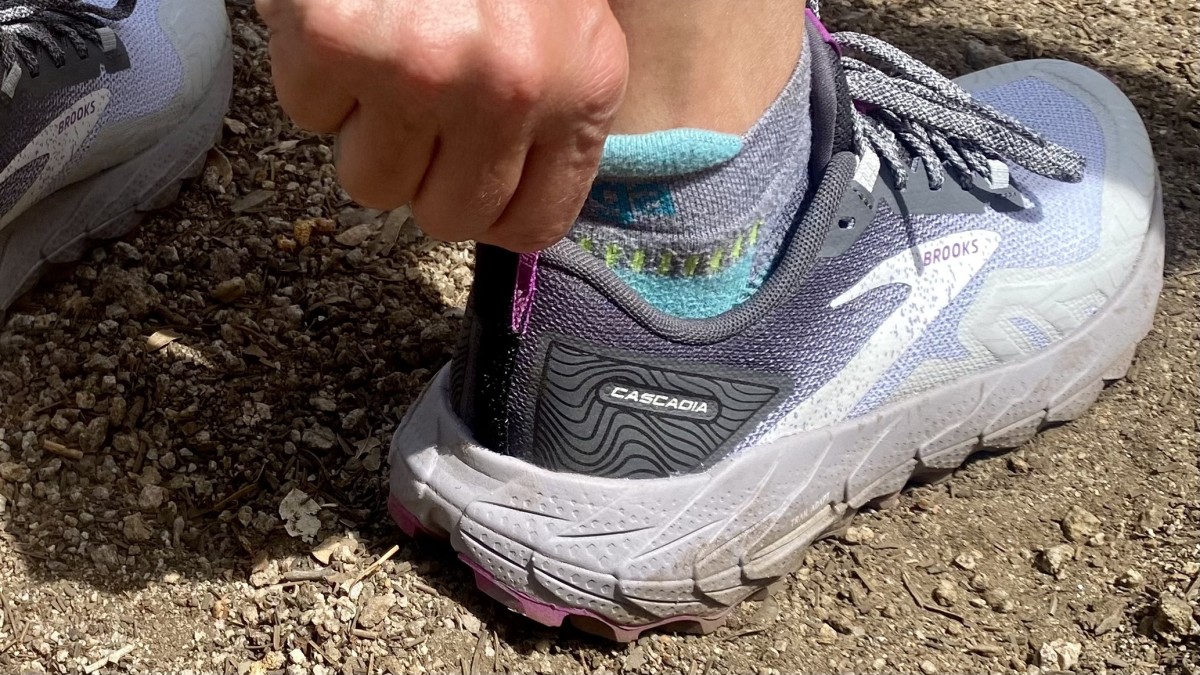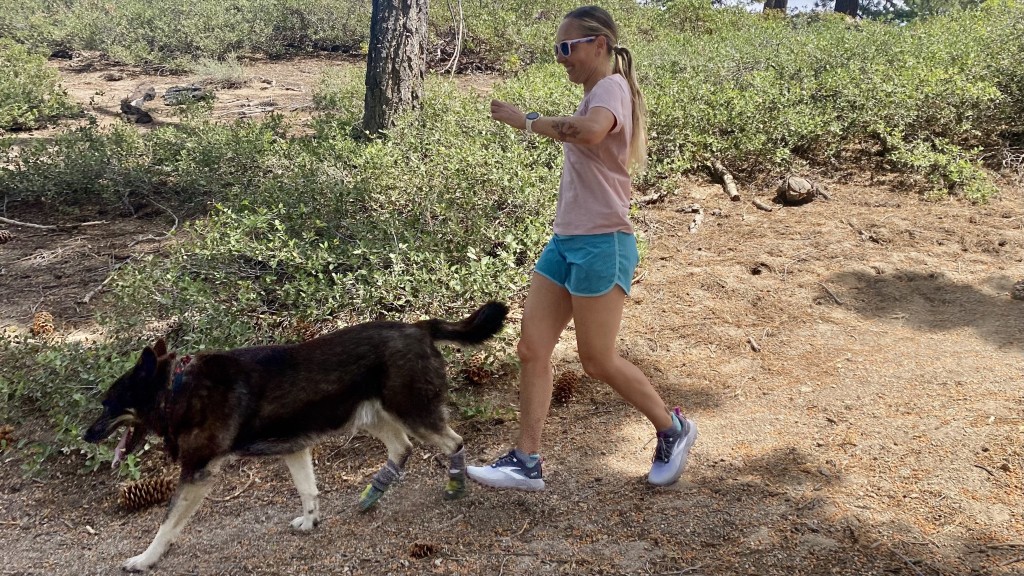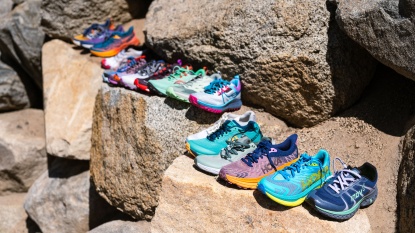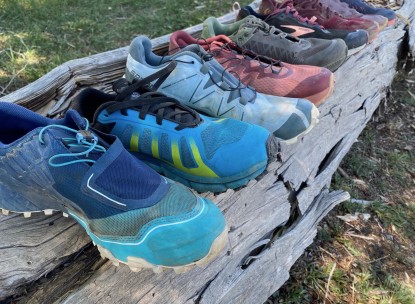Our Verdict
Our Analysis and Test Results
With a rock plate, a tough toe cap, and plenty of Brooks' patented DNA loft cushion, the Cascadia 17 has all of the elements of a great shoe — but it misses the mark on comfort. This 9mm drop shoe had us reaching for Band-Aids to shield hotspots mere moments into our testing runs.
Foot Protection
The Cascadia 17 shines in this metric. Its beefy outsole is ultra-protective and includes an embedded rock plate. The outsole beneath the heel has extra width, which provides protection and additional traction. The toe bumper is laminated, but the outsole extends up toward the toe, creating a solid amount of physical protection. The water-resistant casing of the toe cap extends toward the midfoot, providing adequate protection from splashes and flying sand. The heel cup includes a gaiter trap with extra-strong velcro, so you have the option to add even more protection. The upper mesh is tightly woven and somewhat water-resistant near the toe box, and the added protection surrounding the heel is a nice touch. The cushioning through the midsole is ample, but the rock plate and intense lugs can ride really firm when taken onto roads.
Traction
The TrailTack rubber of the Cascadia 17 provides excellent traction on slippery and loose surfaces. Not only is the outsole grippy, but the 4mm lugs do an excellent job of biting into the terrain beneath you. The width of the outsole near the heel provides a bit of extra traction, and while it doesn't exactly make you feel nimble as you bomb down trails, it gives a significant amount of confidence and additional traction. The arrow-shaped lugs are configured in two directions, with the points facing forward through the forefoot and backward in the rear. Many manufacturers employ this very common lug pattern for mountain-equipped trail shoes. The lugs are firm and showed slight signs of wear after our first two testing runs, further cementing this shoe's standing as one we do not advise for road excursions.
Sensitivity
As tends to be the trend with highly-protective trail shoes, the super-protective Cascadia doesn't wow us with its sensitivity. It has a pretty sizable stack height (we measured 32mm in the heel and 23mm in the forefoot), and the rock plate and thick lugs further dampen ground feel. If you want to feel the nuances of the trail beneath you, better options exist. But if you want adequate protection from sharp rocks and a noticeable rock plate, the Cascadia is worth checking out.
Stability
The Cascadia 17 is super stable in some ways but a little squirrely in others. Its wider-than-average outsole of 4.14 inches provides stability when taking tight corners on loose terrain, but its heel cup is a bit too wide to provide a snug fit, at least in our testers' experience. During our testing runs, we felt distracted by the heel collar's loose fit, so much so that we found ourselves nearly- constantly bending down to tighten our laces. This floppiness led to general feelings of instability, especially on downhills. Otherwise, the Cascadia is seemingly built with stability in mind. It is a neutral and “average-feeling” shoe with plenty of structure to keep you in line as you hurdle down your favorite trails.
Comfort and Fit
This is where the Cascadia lost us this time around. What this trail shoe has in nearly every other metric, it lacks when it comes to comfort and fit. The midfoot is relatively narrow, though a wide option is available. The toe box isn't particularly spacious, but it provides enough space for some toe wiggling. The heel collar is wider than what would match the midfoot, which created some serious discomfort for our testers. With an already tight midfoot, tamping down the laces to prevent slippage in the heel left us with numb toes and, ultimately, heel blisters.
Additionally, the water resistance and protection of the Cascadia 17 make it run hot, further decreasing comfort even on only moderately warm days. As we've mentioned, this shoe has plenty of great qualities. If the profile fits you, this might be your perfect running shoe. Our testers found that after a lengthy break-in period and quite a few Band-Aids, blisters stopped forming, and running in the Cascadia became fun, though it was never a first choice. We recommend trying on all trail shoes before purchasing them, but especially in this case. If the Cascadia fits your feet and ankles, you'll love the bitey, grippy traction, the burly rock plate, and the ample cushion.
Weight
Like many other chunky, protective shoes, the Cascadia is relatively hefty. It certainly isn't the heaviest shoe we've ever tested, but at 8.99 ounces per women's size 6.5 shoe, it doesn't fall into the lightweight category. If you are looking for the level of protection and traction that the Cascadia provides, the weight is worth it. But shedding a few ounces might be preferable if you don't often run trails that need such robust protection.
Should You Buy the Brooks Cascadia 17?
In some ways, we recommend the Cascadia, but in others, we don't. We appreciate aspects of its rugged features, especially from Brooks, who excels at making exceptional light-to-moderate trail shoes. Ultimately, the comfort and fit of the Cascadia just didn't feel right for us, preventing it from being a shoe that we wholeheartedly recommend. If it fits you, the Cascadia will keep you pushing across spikey, rocky terrain. But if it doesn't, you'll probably find it to be as lackluster as we did.
What Other Trail Running Shoes Should You Consider?
If the rock-scrambling prowess of the Cascadia appeals to you, check out the well-tractioned Salomon Speedcross 6 or the Inov-8 Trailfly Ultra G 300 Max. The former has serious lugs and a very water-resistant upper. The latter has a wider, more forgiving profile but comes equipped with some of the most rugged protection available on the market today. Finally, the updated Brooks Catamount 2 is as ready to take on sharp switchbacks but offers a significantly more comfortable fit right out of the box.












